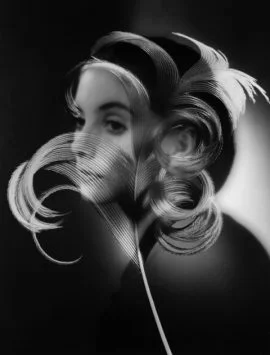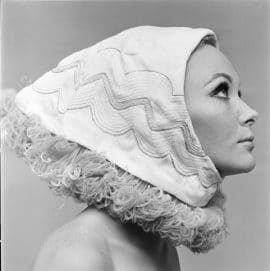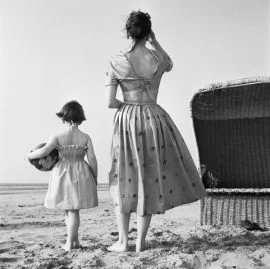Artist: Ata Kando (1913-2017)
Silver Gelatin print, size 26×27,5cm, later print 2003, signed in margin, edition 16/20, in black wooden frame with glass, size 42x42cm.
Ata Kandó (1913-2017) was born in Budapest as Etelka Görög. She came from an intellectual background. Her father, Imra Görög, was a professor of history and a leading translator of Russian literature. Her mother, Margit Beke, was known as an important translator of Scandinavian literature. Since Kandó had trouble pronouncing her own first name as a child, she called herself Ata. The surname Kandó, which she would keep all her life, came from her first husband Gyula Kandó, with whom she had three children.
In the 1930s, Kandó and her husband spent two periods in Paris. Kandó studied photography in Budapest in 1935, with the photographers Klára Wachter and Jószef Pécsi, among others. Until 1938 she worked there as a photographer, mainly for children, but nothing of this work has survived. In 1938, during their second stay in Paris, she opened her own studio on the Avenue de l’Opéra. She and her husband were active in the resistance, including forging documents. After the war, the couple moved back to Paris, but her husband wanted to return to Hungary, leaving Ata with their three children behind.
She worked for the photo press agency Magnum Photos, which was founded by Henri Cartier-Bresson and Robert Capa. She was also a fashion photographer for several Parisian fashion houses. In Paris in 1950 she met Dutch photographer Ed van der Elsken, with whom she moved to the Netherlands in 1954 and married, but divorced a year later. In the Netherlands she became acquainted with other photographers and together with Violette Cornelius she made a book about the Hungarian refugees on the Austrian border after the failure of the Hungarian uprising against communism in 1956. A year later she published ‘Droom in het Woud’, a poetic fantasy photo book featuring her three children, with texts by her son Thomas. In 1961 she made a trip to the Amazon region in South America and became fascinated by the life of the original inhabitants. In 1965 she returned for a longer stay. Her photos, with a strong social commitment to the abuses there, were exhibited and the book Slave of Death was published in 1970. It drew attention to the destruction of the rainforest and the indigenous tribes and their culture. Her photographs have been exhibited worldwide.
A further photo book entitled ‘Kalypso and Nausikaä’ was published in 2004. Kandó was also a teacher at the Hogeschool voor de Kunsten in Utrecht and the Art Academy AKI in Enschede and trained many photographers who later became famous, such as Koen Wessing and Ad van Denderen. In 2004 there was a special exhibition in Amsterdam on the occasion of her 90th birthday, for which she made a choice from her work. In 2006, in the Hungarian embassy in Berlin, there was an exhibition of her photos about the Hungarian refugees. She passed away in 2017, aged nearly 104.








There are no reviews yet.